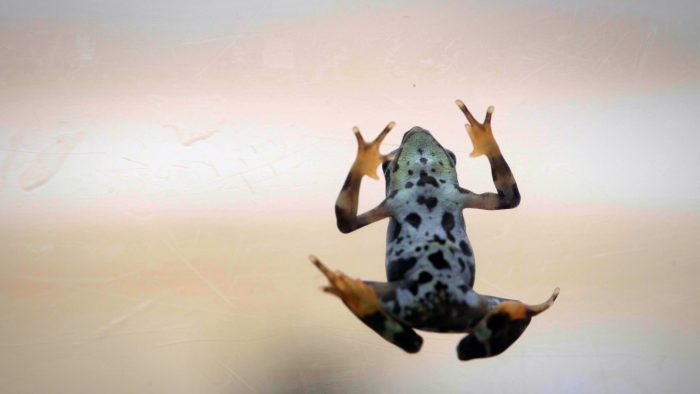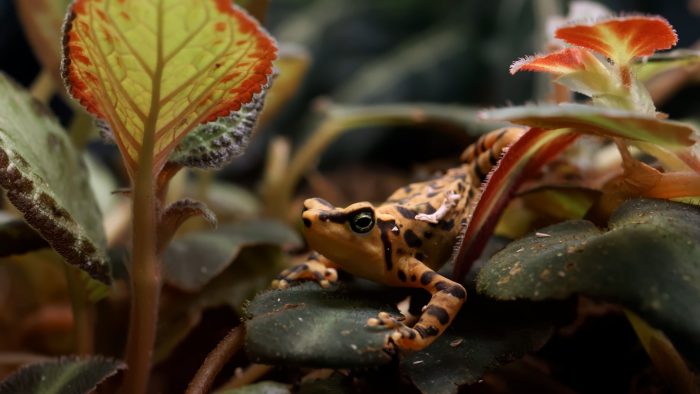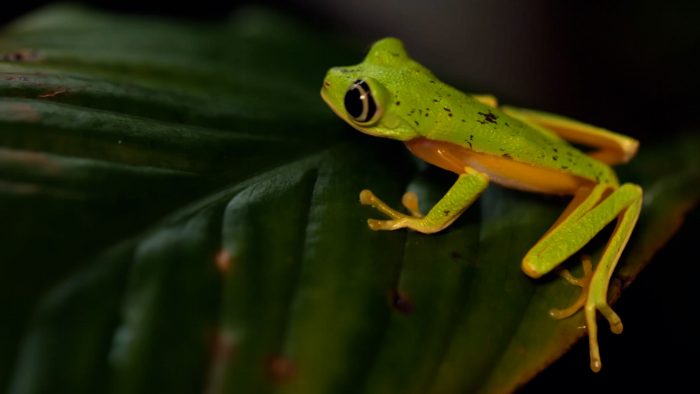How do we stop the amphibian apocalypse?
The Smithsonian’s Tropical Research Institute has a wild hope that an amphibian Ark may help save these special creatures.
Amphibians are the most threatened class of animals in nature. They are extremely susceptible to environmental threats because of their porous eggs and semipermeable skin. Every major threat, from climate change to pollution to disease, affects amphibians and has put them at serious risk.

Screen grab from PBS Nature broadcast, “Wild Hope | Stopping the Amphibian Apocalypse”
Many of the world’s most beloved frogs and amphibians are headed for extinction, but inside “The Ark” in Panama, some of those threatened species are given a fighting chance. Using innovative technology and breakthrough genetics, researchers have ignited a cadre of solutions to save these rare and cherished species.

A leopard frog in its artificial rainforest habitat at STRI. (Screen grab from PBS Nature broadcast, “Wild Hope | Stopping the Amphibian Apocalypse”)
The Ark is part of the Panama Amphibian Rescue and Conservation Project, a joint program between the Smithsonian Tropical Research Institute, the Smithsonian’s National Zoo and Conservation Biology Institute, and several other zoos, houses a variety of species of frogs, some of which no longer exist in the wild. Here, scientists hope to bring these species back from the brink of extinction and solve the world’s worst wildlife pandemic: an amphibian-killing fungus known as chytrid.

Screen grab from PBS Nature broadcast, “Wild Hope | Stopping the Amphibian Apocalypse”
In a quarantined lab, these biologists bathe frogs in fungicide and hope to spark a viable immune response from the captive animals. Meanwhile, in the field, other researchers use artificial intelligence to listen to frog songs and identify so-called “lost frogs” that survive chytrid in the wild — any of which may hold the key to fighting the disease. Safeguarding a future for frogs isn’t easy, but these tactics in Panama have been so successful that they’re being replicated in facilities across the globe. The effort may seem monumental, but the safety and preservation of amphibians worldwide hangs in the balance.
Watch now
Episode 19 of the “Wild Hope” from public television’s Nature series (broadcast March 18) featured STRI’s Gina Della Togna and the Zoo’s Brian Gratwicke’s efforts to stop the amphibian apocalypse.
Learn more
Learn more about this story and ways that YOU can get involved in saving your local biodiversity.
- Follow Wild Hope on Instagram: https://www.instagram.com/wildhopetv/
- Join the community: https://wildhope.tv
- Get the Wild Hope newsletter: http://eepurl.com/irGMng
More from Torch
- Torch | Go ahead and lick that toad. It’s good for you. (si.edu)
- Torch | Smithsonian scientists first to breed critically endangered tree frog (si.edu)
- Torch | Froggie went a courtin’ and he did breed–in the lab (si.edu)
- Torch | Saving amphibians on the brink of extinction (si.edu)
- Torch | Earth Optimism: Frogs (si.edu)
Build your own frog pond
Frogs worldwide are struggling, but with a few simple tools, you can help them thrive in your own backyard! Creating a frog pond is a great way to make your local amphibians more resilient to threats like habitat loss and drought. Even if you have just a small outdoor area, you likely have the space you need to provide a pool that would help your local frogs. Learn the steps you can take to responsibly build your very own frog pond with this guide from the US Department of Agriculture.
Posted: 19 March 2024






